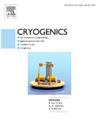研究了经3He传热的GGG盐丸的性能
IF 2.1
3区 工程技术
Q3 PHYSICS, APPLIED
引用次数: 0
摘要
对于绝热消磁制冷机中的GGG盐丸,其作用是在单级ADR中吸收负荷热或在多级ADR中吸收后续阶段的磁化热。单纯依靠纯热传导的常规GGG盐丸设计无法适应高热流密度。本文提出了一种以3He为传热介质的GGG盐丸,旨在提高热流容量,减少涡流加热。该设计结合了涡流加热模拟和3He填充压力计算。建立了基于该盐丸的药品不良反应模拟模型和实验装置。在4 T和4.2 K的初始条件下,绝热退磁实验的最低温度为693 mK。模拟结果表明,GGG轴边缘的磁通密度仅为中心磁通密度的57%,磁场分布不均匀。这使得大约10%的可用熵变无法使用。利用GGG熵,通过实验、数值模拟和公式计算,评估了400 ~ 1000 μW和60 ~ 120 μW两个不同热负荷范围下的制冷量。此外,在等温退磁过程中,模拟的温度分布显示出轻微的温度梯度,证实了3He具有良好的换热效果。本研究为ADR高性能盐丸的设计与优化提供了理论和实验依据。本文章由计算机程序翻译,如有差异,请以英文原文为准。
The performance of GGG salt pill with heat transfer via 3He
For the GGG salt pill in an adiabatic demagnetization refrigerator, its role is to absorb load heat in a single-stage ADR or magnetization heat from subsequent stages in a multi-stage ADR. Conventional GGG salt pill designs relying solely on pure thermal conduction cannot accommodate high heat flux. This paper presents a GGG salt pill utilizing 3He as the heat transfer medium, designed to enhance heat flux capacity and minimize eddy current heating. The design incorporates simulations of eddy current heating and calculations of 3He filling pressure. An ADR simulation model and experimental setup based on this salt pill are developed. The adiabatic demagnetization experiments achieve a minimum temperature of 693 mK under initial conditions of 4 T and 4.2 K. Simulation results reveal a non-uniform magnetic field distribution, where the magnetic flux density at the edge of the GGG axis is only 57 % of that at the centre. This renders approximately 10 % of the available entropy change unusable. Cooling capacity under two distinct heat load ranges (400–1000 μW and 60–120 μW) is evaluated through experiments, numerical simulations, and formula calculations using the GGG entropy. Furthermore, simulated temperature distributions during isothermal demagnetization demonstrate slight temperature gradients, confirming the superior heat transfer effect of 3He. This work provides theoretical and experimental foundations for the design and optimization of high-performance salt pills in ADR.
求助全文
通过发布文献求助,成功后即可免费获取论文全文。
去求助
来源期刊

Cryogenics
物理-热力学
CiteScore
3.80
自引率
9.50%
发文量
0
审稿时长
2.1 months
期刊介绍:
Cryogenics is the world''s leading journal focusing on all aspects of cryoengineering and cryogenics. Papers published in Cryogenics cover a wide variety of subjects in low temperature engineering and research. Among the areas covered are:
- Applications of superconductivity: magnets, electronics, devices
- Superconductors and their properties
- Properties of materials: metals, alloys, composites, polymers, insulations
- New applications of cryogenic technology to processes, devices, machinery
- Refrigeration and liquefaction technology
- Thermodynamics
- Fluid properties and fluid mechanics
- Heat transfer
- Thermometry and measurement science
- Cryogenics in medicine
- Cryoelectronics
 求助内容:
求助内容: 应助结果提醒方式:
应助结果提醒方式:


